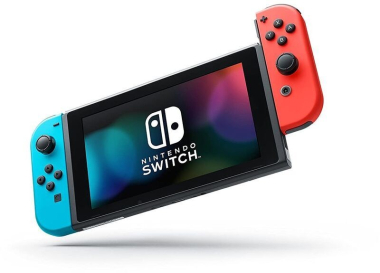When I first opened the Nintendo Switch's box, I was immediately struck by its sleek, modern design. The Joy-Con controllers, whether you choose the neon blue and red or the more understated gray, feel incredibly smooth to the touch, almost as if they were begging to be handled. They exude an air of quality that's been missing from previous Nintendo consoles for years.
Lightweight Yet Sturdy Build
One of the aspects that took me by surprise was how lightweight the central tablet piece of the Switch is. Despite being feather-light at under a pound with both Joy-Con controllers attached, the device still manages to feel sturdy due to its mostly metal construction. It’s an unusual balance that gives the console a premium feel without adding unnecessary heft.
Ergonomics in Handheld Mode
Holding the Switch in handheld mode is surprisingly comfortable for long gaming sessions. Both Joy-Con controllers attach seamlessly to the sides, converting the tablet into a fully portable gaming device. The arrangement feels natural, and the weight distribution ensures that my hands didn’t tire easily, even after hours of continuous play.
The Magic of Modular Design
The real ingenuity of the Switch lies in its modular design. On the one hand, it’s a home console that connects effortlessly to a TV through its dock. On the other, it can transition into a portable gaming setup or a stand-alone touch screen tablet with minimal effort. The range of configurations is truly staggering, and it provides a flexibility that no other console on the market currently offers.
Visual Appeal and Bright Display
The Switch’s 6.2-inch, multi-touch LCD screen is among the best I’ve seen on any gaming console. This 720p display is bright enough to use in indirect sunlight and produces colors so vibrant that games look amazing, whether I’m sitting at home or out in the park. The viewing angles are wide enough to easily share the screen when playing multiplayer games, which became particularly useful during family get-togethers.
Challenges with the Dock
While the dock does its job well by allowing instant transition from handheld to TV mode, it has some limitations. To be honest, I find it a little barebones. It serves as a charging station and an HDMI passthrough but lacks additional functionalities that could have elevated its utility, like an Ethernet port or more control buttons.
Controller Comfort and Limitations
Attaching the Joy-Con controllers to the Joy-Con Grip transforms them into a more traditional gamepad. Although it isn’t as ergonomic or comfortable as Sony's DualShock 4, it manages to feel adequate for most gaming genres. However, the layout does have some quirks — the Minus button, for example, is so close to the analog stick that hitting it precisely requires some dexterity.
Performance in Various Configurations
Performance-wise, the Switch is a mixed bag. The Legend of Zelda: Breath of the Wild, despite its beauty, occasionally struggles to keep a steady frame rate when lots of elements are on the screen, especially in TV mode. However, these performance hitches are significantly alleviated in handheld mode, where the lower 720p resolution helps maintain a more consistent frame rate.
Battery Life and Portability
One of the drawbacks of the Switch’s portable nature is its battery life, especially for graphically intense games like Zelda. Casual gaming sessions on the go barely stretched past two hours, forcing me to carry a USB battery pack during long commutes. Less demanding games, however, offered longer battery life, nearing five hours on a full charge.
The Versatility of Controls
Nintendo has outdone itself with the inclusion of motion-tracking accelerometers and HD Rumble in the Joy-Con controllers. These features add layers of tactile feedback and precision that elevated simple mini-games in 1-2-Switch to genuinely immersive experiences. Their inclusion of an NFC reader for amiibo is also a smart touch, allowing for additional in-game content and bonuses.
Design Flaws for Tabletop Mode
Using the Switch in tabletop mode is another feature that adds to its versatility, but it’s not without its shortcomings. The built-in kickstand is far from reliable, and its location on the console means you can’t charge the device while it’s propped up. This setup felt more like a stopgap solution rather than a well-thought-out feature.
Storage and Expandability
The Switch comes with a rather limited 32GB of internal storage. Considering how downloadable games are gaining popularity, I quickly found myself running out of space. Thankfully, it supports microSD cards, allowing for significant storage expansion, which became an almost necessary addition as my game library grew.
Joy-Con Issues and Connectivity
While the Joy-Con controllers are packed with features, they aren’t immune to issues. I experienced frequent de-syncing problems with the left Joy-Con, which became particularly troublesome during action-packed sequences in Breath of the Wild. This issue persisted even when I was only 10 feet away from the console, necessitating a rather close proximity for consistent performance.
Aging Hardware in a New Package
Under the hood, the Switch is powered by a custom Nvidia Tegra X1 chipset. Though impressive for a mobile device, it falls short compared to current-gen home consoles like the PS4 and Xbox One. This difference is most noticeable in multi-platform games, where the Switch often requires graphical compromises to maintain performance standards.
Brand Reliability and Software Ecosystem
Nintendo’s reputation for delivering innovative yet family-friendly gaming experiences is well-earned, and the Switch is no exception. However, its online services and multiplayer functionalities still lag behind competitors, both in terms of stability and features. Nintendo's current subscription service, while economical, lacks the robustness seen in Xbox Live or PlayStation Network.
Game Library and Exclusives
Probably the biggest selling point for the Switch is its ever-growing collection of exclusive games. Titles like Breath of the Wild, Super Mario Odyssey, and Animal Crossing: New Horizons deliver high-quality, engaging content that cannot be found on any other platform. These exclusives play a significant role in the console’s appeal for both casual gamers and die-hard Nintendo fans.
Safety and Build Quality for Younger Gamers
One aspect where the Switch excels is in its suitability for younger gamers. The Joy-Con controllers, though small, are designed to be child-friendly, and the durable construction of the Switch's central tablet can withstand a reasonable amount of rough handling. Parental controls are comprehensive, allowing parents to set playtime limits and restrict content based on age ratings.
Accessories and Bundling Options
The Switch’s versatility extends to its array of accessories. From the Pro Controller for more traditional gameplay to various carrying cases and stands, Nintendo offers a suite of peripherals to enhance the Switch experience. However, these accessories add up, and some, like the Joy-Con Charging Grip, feel like they should have been included in the base package given their utility.
User Interface and Ease of Use
The Switch’s user interface is both intuitive and responsive. It features a minimalist design that eschews clutter, making it easy to navigate through the home screen and settings. The touch screen responsiveness is excellent, comparable to modern smartphones, which makes menu navigation a breeze.
Age Range and Audience
The Nintendo Switch appeals to a broad age range, making it a fantastic choice for families. Its vast library includes everything from mature titles like Doom to child-friendly games like Pokémon and Mario Kart 8 Deluxe, catering to a variety of tastes and preferences.
Software Limitations and Third-Party Support
One area where the Switch lags is in its software ecosystem. The eShop, while functional, lacks the robustness and user-friendliness found in competitors’ online stores. Furthermore, third-party support, though improving, still falls short of what’s available on PlayStation and Xbox platforms. Many blockbuster titles either arrive late or not at all, limiting the console's mainstream appeal.
Bundling Options and Value
I appreciate the different bundling options Nintendo offers. Buying the base model includes the necessary components to get started, but there are bundles that feature popular games like Mario Kart 8 Deluxe or Animal Crossing: New Horizons, making them more attractive deals for first-time buyers. However, one can't help but feel that certain elements, such as the aforementioned charging grip or a larger internal storage option, would have significantly boosted the base package’s value.
Compatibility with Amiibo and Other Accessories
The Switch's built-in NFC reader offers compatibility with a plethora of amiibo figures. Scanning these figures can unlock unique content in supported games, adding an extra layer of interactivity. This feature is particularly well-executed in games like The Legend of Zelda: Breath of the Wild and Super Smash Bros. Ultimate, where amiibo figures can significantly enrich the gameplay experience.
Handling and Durability
One of my primary concerns going into my experience with the Switch was its durability, particularly given its portable nature. I was pleased to discover that it’s sturdily built, withstanding occasional drops and bumps without significant damage. The Joy-Con controllers, although small, are equally durable, and their attachment mechanism to the tablet is robust enough to handle repeated use.
Game Card Storage and Digital Downloads
Managing game cards can be a bit of a hassle, especially when out and about. The small size of the game cards makes them easy to lose, forcing me to be extra cautious. Conversely, digital downloads simplify the process but quickly eat away at the limited internal storage, emphasizing the need for additional microSD cards for serious gamers.
Audio Experience
While the Switch's speakers are decent for a handheld device, they aren’t extraordinary. Headphones are almost a must for an immersive audio experience. However, the lack of Bluetooth audio support is a glaring omission in today’s wireless era, making it inconvenient for those who have invested in premium wireless headphones.
The Competitive Edge
Despite its technical limitations, the Nintendo Switch holds its own in the competitive gaming console market primarily due to its unique selling points. Its versatility and library of exclusive games put it in a niche that neither PlayStation nor Xbox can directly compete with, making it the go-to console for fans of Nintendo's beloved franchises.
Family-Friendly Features
Nintendo's strong focus on creating a family-friendly environment is evident throughout the Switch's ecosystem. From robust parental controls to a plethora of family-friendly game titles, it is a console built for households with children. It allows for easy monitoring and managing of game time, ensuring a balanced approach to gaming.
A Hopeful Glimpse into the Future
What excites me most about the Switch is its potential. With continuous updates and the promise of new and exclusive titles, the Switch’s library and functionality are improving constantly. Even considering its current drawbacks, playing on the Switch is a unique experience that offers something its competitors simply cannot provide.
Screenshots







